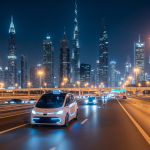The United Arab Emirates is positioning itself as a global hub for autonomous vehicles (AVs), with plans to make at least 25% of all trips in Dubai and Abu Dhabi driverless within the next decade and a half. While the initiative promises cutting-edge technology, reduced emissions, and economic growth, it also threatens the livelihoods of tens of thousands of migrant taxi drivers.
Chinese and U.S. companies, including WeRide, Baidu, Uber, and Pony.ai, are racing to deploy fleets in the UAE, lured by government incentives and advanced infrastructure. Abu Dhabi has already completed nearly 30,000 AV trips covering over 430,000 kilometers, aiming to make a quarter of all journeys autonomous by 2040. Dubai’s strategy is even more ambitious, targeting the same percentage by 2030, with projections of $6 billion in annual savings and 400 million fewer commuting hours.
For the UAE’s 30,000 cabbies, mostly South Asian migrant workers, the shift could be devastating. Many lack retraining opportunities, English proficiency, or even awareness of the scale of disruption approaching. “Driverless cars are the future,” said Faisal Q, a Pakistani driver who has worked in the country for three decades. “What about my future?”
Experts warn that automation will hit low-income migrant workers hardest. “Large-scale displacement is inevitable,” said Shahzad Sheikh, a Middle East auto industry reporter. “Tech is now coming for low-income workers.”
The UAE has created the Smart & Autonomous Vehicle Industries Cluster to attract investment, provide testing facilities, and eventually create up to 50,000 jobs in related industries. Officials highlight roles such as safety officers, service technicians, remote operators, and mapping specialists.
WeRide, holding the UAE’s first autonomous-driving test license, is piloting fully driverless rides without safety officers and planning a commercial rollout later this year. Uber has partnered with WeRide in Abu Dhabi, while Baidu’s Apollo Go has teamed up with local firm AutoGo to build the city’s largest driverless fleet. Pony.ai is also preparing for a Dubai launch by 2026.
Yet for drivers like Wisal Khurshid, the timeline feels all too real. “These cars will finish our job,” he said, fearing that machines could replace years of local driving experience. Without substantial employer or government support, many may be forced to return home or seek work in other Gulf countries.
Some see opportunity in the transition. Mohammad, a safety officer for AVs, helps monitor and guide autonomous systems in case of technical issues. “It’s an exciting and historic experience,” he said, though he acknowledged the need for constant vigilance during rides.
While proponents argue that AV deployment will create new skilled positions and a safer, greener transport system, critics caution that the number of new jobs may not match those lost. “If a company has 1,000 taxis and switches to autonomous vehicles, that’s 1,000 drivers it won’t need,” Sheikh noted.
As Dubai and Abu Dhabi race toward a driverless future, the nation’s experiment will serve as a test not just for autonomous technology, but for how societies manage the human cost of innovation.










